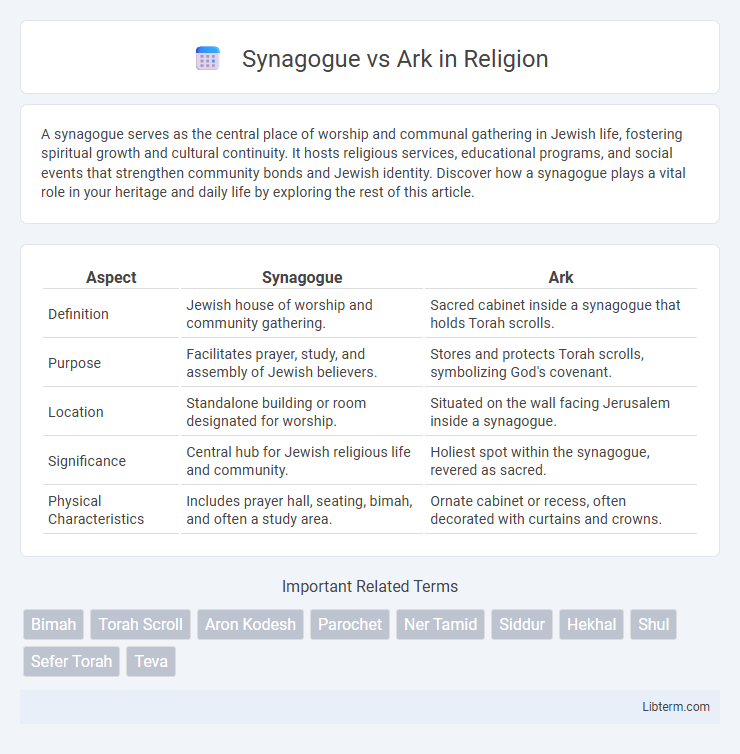A synagogue serves as the central place of worship and communal gathering in Jewish life, fostering spiritual growth and cultural continuity. It hosts religious services, educational programs, and social events that strengthen community bonds and Jewish identity. Discover how a synagogue plays a vital role in your heritage and daily life by exploring the rest of this article.
Table of Comparison
| Aspect | Synagogue | Ark |
|---|---|---|
| Definition | Jewish house of worship and community gathering. | Sacred cabinet inside a synagogue that holds Torah scrolls. |
| Purpose | Facilitates prayer, study, and assembly of Jewish believers. | Stores and protects Torah scrolls, symbolizing God's covenant. |
| Location | Standalone building or room designated for worship. | Situated on the wall facing Jerusalem inside a synagogue. |
| Significance | Central hub for Jewish religious life and community. | Holiest spot within the synagogue, revered as sacred. |
| Physical Characteristics | Includes prayer hall, seating, bimah, and often a study area. | Ornate cabinet or recess, often decorated with curtains and crowns. |
Introduction to Synagogue and Ark
A synagogue serves as the Jewish community's central place of worship, study, and assembly, often housing important religious artifacts including the Ark. The Ark, known as the Aron Kodesh, is a sacred cabinet within the synagogue that contains the Torah scrolls, symbolizing the covenant between God and the Jewish people. Together, the synagogue and Ark create a spiritual environment essential for Jewish religious practices and communal life.
Definition of a Synagogue
A synagogue is a Jewish house of worship and community center, serving as a place for prayer, study, and assembly. It typically includes an ark, known as the Aron Kodesh, which is a sacred cabinet that houses the Torah scrolls. While the synagogue encompasses the entire building and its functions, the ark specifically refers to the recessed space or cabinet where the Torah is kept.
Understanding the Ark (Aron Kodesh)
The Ark, or Aron Kodesh, is a sacred cabinet within the synagogue that houses the Torah scrolls, symbolizing the holiest spot in Jewish worship. Positioned on the wall facing Jerusalem, the Ark is often ornately decorated and serves as the focal point during prayer services. Understanding the Ark's significance highlights its role as a physical and spiritual vessel preserving Jewish tradition and law.
Historical Origins of Synagogues
Synagogues originated during the Babylonian exile in the 6th century BCE as communal centers for Jewish prayer, study, and assembly, evolving from earlier Temple worship. The Ark, or Aron Kodesh, developed as a sacred cabinet within synagogues to house the Torah scrolls, symbolizing the Holy of Holies from the ancient Temple in Jerusalem. This architectural and religious evolution reflects the transition from centralized Temple rituals to decentralized community worship in diaspora.
The Role of the Ark in Jewish Worship
The Ark, or Aron Kodesh, serves as the sacred cabinet in a synagogue that houses the Torah scrolls, symbolizing the covenant between God and the Jewish people. Central to Jewish worship, the Ark is positioned on the wall facing Jerusalem, guiding congregants during prayer and Torah readings. Its revered status underscores the importance of the Torah in religious life, making the Ark the focal point within the synagogue space.
Synagogue Architecture: Focus on the Ark
The Ark, or Aron Kodesh, is the focal point of synagogue architecture, symbolizing the holiest space where Torah scrolls are kept. Positioned on the eastern wall facing Jerusalem, the Ark is often ornately designed with intricate woodwork, metalwork, and decorative fabrics to emphasize reverence. Its centrality in the sanctuary underscores the Ark's spiritual importance within the synagogue's overall architectural layout.
Rituals Associated with the Ark
The Ark, or Aron Kodesh, in a synagogue serves as the sacred cabinet housing Torah scrolls, central to Jewish worship rituals. Rituals associated with the Ark include removing the Torah scrolls during services, often accompanied by specific prayers, songs, and the congregation standing in reverence. The opening and closing of the Ark, as well as the handling of the Torah, follow precise ceremonial customs that underscore the Ark's spiritual significance within the synagogue setting.
Synagogue vs Ark: Key Differences
The synagogue serves as a Jewish house of worship and community gathering, while the ark, or Aron Kodesh, is a sacred cabinet within the synagogue housing the Torah scrolls. Key differences include the synagogue's role as a physical and social institution versus the ark's function as a religious object central to Jewish liturgy and symbolism. The ark is typically located on the wall facing Jerusalem, emphasizing its spiritual significance, whereas the synagogue encompasses a broader space with areas for prayer, study, and assembly.
Symbolic Significance of the Ark
The Ark in a synagogue holds profound symbolic significance as it houses the Torah scrolls, representing the covenant between God and the Jewish people. Architecturally, the Ark is often ornately decorated, emphasizing its sacred role as the spiritual heart of the synagogue. Its placement and design reflect reverence, serving as a focal point for worship and Jewish identity.
Conclusion: Interconnection of Synagogue and Ark
The synagogue and the ark are intrinsically connected as the ark serves as the sacred focal point within the synagogue, housing the Torah scrolls central to Jewish worship and tradition. This relationship underscores the synagogue's role as both a communal gathering space and a spiritual center where the ark symbolizes divine presence and covenant. Together, they embody the unity of faith, law, and community essential in Judaism.
Synagogue Infographic

 libterm.com
libterm.com